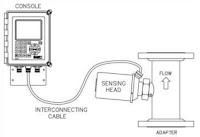 |
Example flow loop diagram
showing role of transmitter. |
Transmitters are process control field devices. They receive input from a connected process sensor, then convert the sensor signal to an output signal using a transmission protocol. The output signal is passed to a monitoring, control, or decision device for use in documenting, regulating, or monitoring a process or operation.
Transmitters are available for almost every measured parameter in process control, and often referred to according to the process condition which they measure.
The refractive index determines how much light is bent, or refracted, when entering a material. When light moves from one medium to another, it changes direction (refracted). This change in the direction of the light can be measured and applied to properties of the material.
Industrial Refractive Index transmitters directly measure the refractive index of process fluids. It then conditions the input signal, making it linear, and then converts that signal into any number of customer-desired units (Brix, Percent Solids, Dissolved Solids, SGU, R.I., etc.) and transmits a standard, linear electrical output (4 to 20 mA) that can be utilized by receiving instruments and displays.
Many transmitters are provided with higher order functions in addition to merely converting an input signal to an output signal. On board displays, keypads, Bluetooth connectivity, and a host of industry standard communication protocols can also be had as an integral part of many process transmitters. Other functions that provide alarm or safety action are more frequently part of the transmitter package, as well.
Industrial Refractive Index transmitters have evolved from simple signal conversion devices to higher functioning, efficient, easy to apply and maintain instruments utilized for providing input to process control systems.
For more information on Industrial Refractive Index transmitters visit
Electron Machine at
http://www.electronmachine.com or call
352-669-3101.



